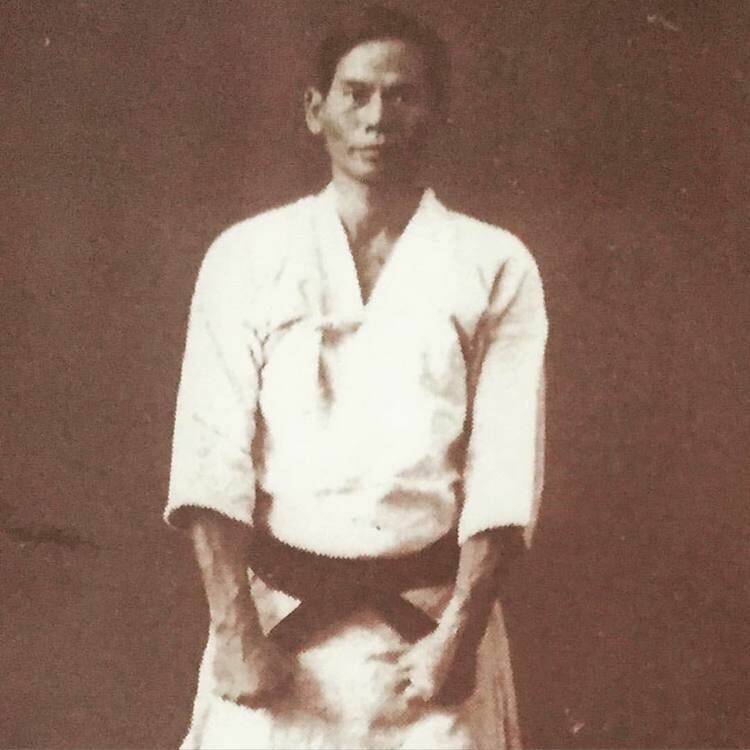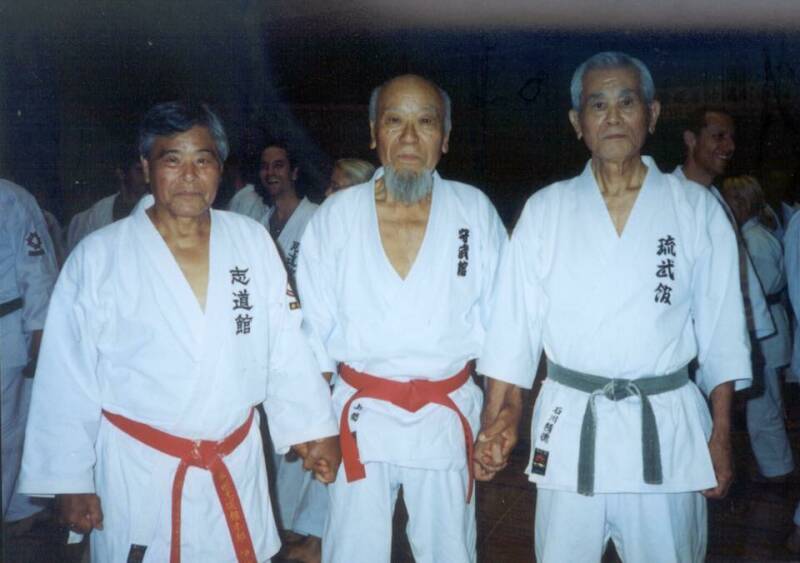The teachings of Shinpan Gusukuma Sensei
- By Seikichi Iha Sensei
Published: May 23, 2020

Shinpan Gusukuma, also known by his Japanese name Shinpan Shiroma, was born in Shuri, Okinawa, in 1890. In 1903, at the age of thirteen, he began to study karate with Anko Itosu, and in 1908 he began training with Kanryo Higaonna, together with his contemporary Kenwa Mabuni. From Kanryo Higaonna, Shinpan Gusukuma learned the kata Sanchin.
In 1909, Shinpan Gusukuma was inducted into the Japanese Navy. He became a school teacher by profession and worked at the Shuri Dai Ichi Elementary School where he also taught karate. Among his students were Yoki Uema (1920 - 2011, founder of Shorin-Ryu Shubukan), Seiichi Iju (who was the first teacher of Shuguro Nakazato, the founder of Shorin-Ryu Shorinkan, and who taught the latter the kata Gojushiho), Seitoku Ishikawa (1925 - 2013) and Seikichi Iha (born in 1932). There is not much written about Gusukuma Sensei, but lucky for us Chris Willson and James Pankiewicz had a fantastic interview with Seikichi Iha Sensei in 2020. In this interview Iha Sensei talks a lot about Gusukuma Sensei. In this article, I collected all the information Iha Sensei gave us. For the full interview: https://bit.ly/2PGLmBN

Shinpan Gusukuma teaching karate in front of Shuri Castle, ca. 1938. Front row, third from the right is Seitoku Ishikawa Sensei.
“My name is Iha Seikichi. In 1932, I was born in Tanabaru in Nishihara Town and I grew up there. I’m 87 years old this year. I just celebrated my tookachi (88th year celebration). Many people came from overseas and I had a great 88th year celebration. I am very happy. I first learned karate when I was 18 years old. I joined Gusukuma Shinpan Sensei’s dojo, a highly respected teacher of Suidi. Later, after Gusukuma Sensei passed away, then I joined another dojo of the same Shuri-te lineage, studying under Miyahira Sensei, who was designated an intangible cultural asset.”
“At that time, there was nothing to call a karate dojo. Also, there were no teachers who earned a living from karate. We couldn’t find any karate dojo’s, especially since I lived in the countryside. So at that time, I became acquainted with the third son of Gusukuma Sensei, he introduced his father to me. So I started karate. Gusukuma Sensei was a school teacher. He was famous for missing al of his nails from nukite practice. He was also a chiropractor, so when the kids got a sprain, he treated them. Always hard repetitive training. He followed in the way of his teacher Itosu Anko Sensei. Sometimes Itosu Sensei would say to Gusukuma Sensei: “Bring me sotetsu leaves” (cycad sago palm). Gusukuma Sensei looked for the sago palm fronds and brought them to Itosu Sensei. Itosu Sensei said: “I don’t need too much of it. Bring me just one frond.”Gusukuma Sensei said that when he brought it to Itosu Sensei, Itosu Sensei tore of a leaf from the palm frond every time they completed a kata. The palm fronds have so many leaves. When the frond had lost all its leaves, training ended. So Gusukuma Sensei trained like that. They didn’t do any warm-up exercises. That’s why, when he got home, his muscles really hurt. That’s how it was done.”
“Gusukuma Sensei said: “Karate has three elements: kata, kata no bunkai (jutsu), and oyo bunkai (ryaku).” The kata has to be applied practically. So wether the karate type is an old fashioned kata or a basic kata, even if you do it well, it cannot be said that karate could be done effectively without practical study. With repetition, you can learn karate techniques, remember them, and improve them. Even if you remember 20 or 30 types of kata, if you don’t practice much, you can’t improve. Absolutely there’s no progress and development without strenuous training. If you want to be better than others, you have to train longer and harder. If they do it 10 times, you do it 100. Gusukuma Sensei graciously taught us, in great detail, like that. The movements of karate are in the teacher’s mind, and the system is in it also.”
“Karate power improves in proportion to usage. Practicing karate with full effort is the key point. When you train hard, you become tired and lose power. That is when you learn how to control your power. The idea is that in any kamae, you are with zero tension. When you need to act against an opponent, the application is proportionate, and only what is needed. All unnecessary tension is to be avoided. You go from zero to 100 in an instant, and then return to kamae. Kamae then strike. Kamae then block. Releasing your outpower comes from not holding onto unnecessary tension. Controlling your power is what Sensei explained to me.”
“So the most memorable thing from that time (1950’s) was some using karate for bullying. People would go around practicing their karate by bullying (picking fights). Gusukuma Sensei told us, karate training is futile for those who don’t have a job. It can be self-destructive, and can be harmful to others. Most Okinawans worked at the military bases after the war, but some karateka didn’t have jobs and used karate for the wrong reasons. Don’t forget your main job! Practice karate when you have spare time. Balance them both. You must have the mental attitude to strengthen mind and body. That was the most memorable thing.”
“Gusukuma Sensei was teaching us mainly using the method of kata application (bunkai). I’m not sure about the old days, before the war, but there was a teacher Uema Sensei, who has since passed away. He was a student of Gusukuma Sensei before I was, I was after the war. Before the war, Kyan Chotoku Sensei, about once a week, would come and study together with Gusukuma Sensei at his place.”
“One story I heard from Gusukuma Sensei, when he was training Goju-Ryu, every three hours he would wake up with tingling muscles. He wasn’t able to sleep, he’d wake up and resume training to relieve his muscle fatigue. This kind of exhaustion comes after three hours of training.”
“When studying with Gusukuma Sensei, you also had to be self-motivated. Sometimes, when training in class, you weren’t sure how to apply the power. And Sensei would say: “Here, and here, fix these things.” Homework, for us to take home. I thought it would be disrespectful to Sensei if I dind’t practice at home. So I did my homework, by myself, until I was comfortable doing it. At that time, I’d practice with Gusukuma Shinpan Sensei twice a week.”
“Gusukuma stressed no wabadi, no over-motion (no excessive movement). It’s easy to do things with excessive motion. That’s the way things are often done. Everything should come from connection with the hips. If you try to pick something heavy away from the body, it’s not possible, even if you strain yourself. When you apply force, you don’t have to apply excessive force. Remember, no wabadi, (no excessive movement), as Gusukuma Shinpan Sensei said.”
Published by Olaf Steinbrecher after consultation with and approval by Chris Willson.
End note: Gusukuma Sensei lost many students during The Battle of Okinawa. After the war, he reopened a dojo at Tera village, Shuri. Gusukuma Sensei always told his students that he would refuse to become bedridden or get to a point where he could not take care of himself.He died in 1954 at the age of 64. On the day of his death, he taught class and trained for two hours. He ate a light dinner and went to bed early. Three hours later, when his wife checked in on him, they found that he had died in his sleep. That day his students stated that Gusukuma had spoken of his own death. He had said: “My body is strong, but everyday my will gets even stronger. I will pick my day and die at peace with no long illness or discomfort for my family. Wait and see.”(Source: ‘Shinpan Gusukuma 1890 - 1954’ https://milos.io/shinpan-gusukuma-1890-1954)

Three of Shinpan Gusukuma Sensei's students: Seikichi Iha Sensei, Yoki Uema Sensei and Seitoku Ishikawa Sensei.